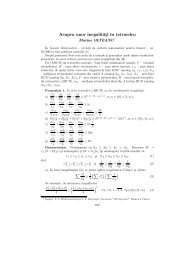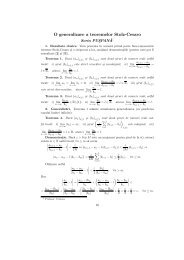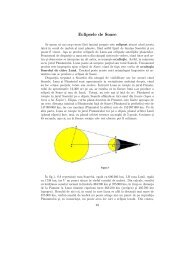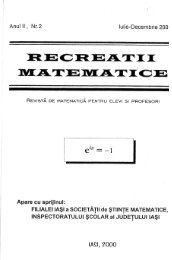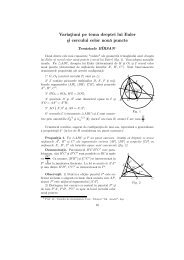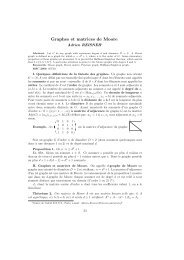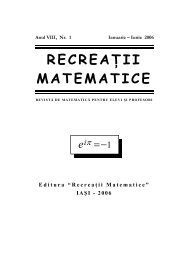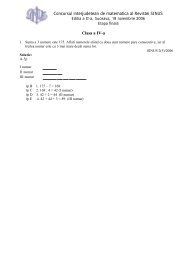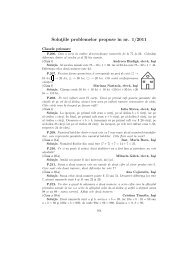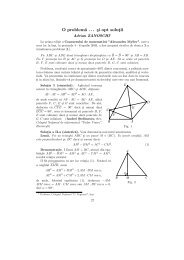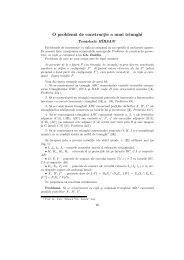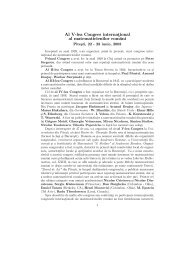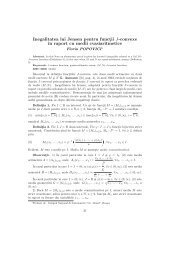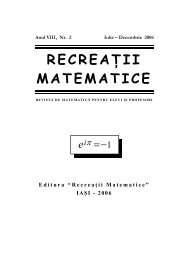x - Recreaţii Matematice
x - Recreaţii Matematice
x - Recreaţii Matematice
You also want an ePaper? Increase the reach of your titles
YUMPU automatically turns print PDFs into web optimized ePapers that Google loves.
B. Highschool Level<br />
L176. Let D, E, F be the projections of the centroid G of the triangle ABC onto<br />
the lines BC, CA, and respectively AB. Show that the Cevian lines AD, BE and CF<br />
meet at a unique point if and only if the triangle is isosceles.<br />
Temistocle Bîrsan, Ia¸si<br />
L177. We consider the triangle ABC with its centroid G and Lemoine ′ s point L.<br />
Denote by M and N the projections of G onto the interior and exterior bisector lines<br />
of angleA and let P and Q be the projections of L on the interior and respectively<br />
exterior bisector lines of angleA. Prove that the lines GK, MN and P Q meet at the<br />
same point.<br />
Titu Zvonaru, Comăne¸sti<br />
L178. Let ABCD be a rhombus with its side length ℓ = 1 and the points<br />
A1 ∈ (AB), B1 ∈ (BC), C1 ∈ (CD), D1 ∈ (DA). Prove that A1B 2 1 +B1C 2 1 +C1D 2 1 +<br />
D1A 2 1 ≥ 2 sin 2 A.<br />
Neculai Roman, Mirce¸sti, Ia¸si<br />
L179. Prove that the following inequality holds in any triangle:<br />
2(9R 2 − p 2 )<br />
9Rr<br />
≥ cos2 A<br />
sin B sin C + cos2 B<br />
sin C sin A + cos2 C<br />
≥ 1.<br />
sin A sin B<br />
I.V. Maftei and Dorel Băit¸an, Bucure¸sti<br />
L180. Determine the minimum number of factors in the product P = sin π<br />
·<br />
4n sin 2π 3π<br />
· sin<br />
4n 4n · . . . · sin (22n−1 − 1)π<br />
4n , n ∈ N ∗ , so that P < 10 −9 .<br />
Ionel Tudor, Călugăreni, Giurgiu<br />
L181. Let P be a point on the circular boundary of a half-disc, and d the tangent<br />
at P to this boundary. Denote by C the rotation body obtained by the rotation of<br />
the half-disc around the line d. Study the variation of the volume of C as a function<br />
of the position of point P.<br />
Paul Georgescu and Gabriel Popa, Ia¸si<br />
L182. Let (xn)n≥1 be a sequence of integer numbers with the property that<br />
xn+2 − 5xn+1 + xn = 0, ∀n ∈ N ∗ . Show that if a term of the sequence is divisible by<br />
22 then infinitely many terms there of have this property.<br />
Marian Tetiva, Bârlad<br />
L183. Let us consider the numbers a ∈ Z, n ∈ N ∗ and the polynomial p(X) =<br />
X 2 + a X + 1. Show that there exist a polynomial with integer coefficients qn and an<br />
integer number bn such that p(X)qn(X) = X 2n + bnX n + 1.<br />
Marian Tetiva, Bârlad<br />
L184. Show that the function f:N∗ ×N∗→N∗ , f(x, y)= x2 + y2 + 2xy − x − 3y + 2<br />
,<br />
2<br />
is bijective.<br />
Silviu Boga, Ia¸si<br />
L185. Let f : R → R be a function with the property that |f(x + y) − f(x) −<br />
f(y)| ≤ |x − y|, ∀x, y ∈ R. Show that lim f(x) = 0 if and only if lim xf(x) = 0.<br />
x→0 x→0<br />
Adrian Zahariuc, student, Princeton<br />
89



